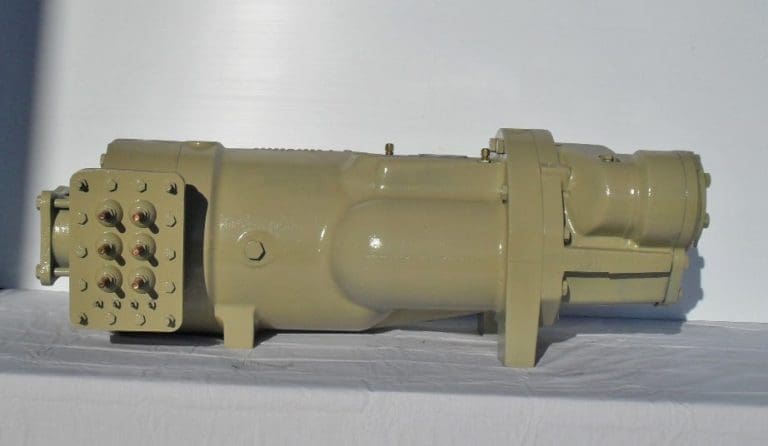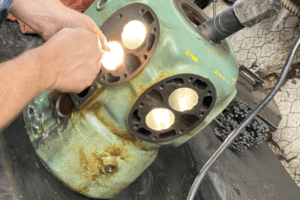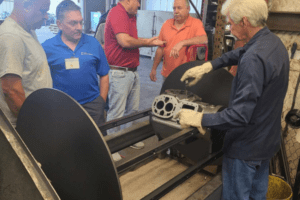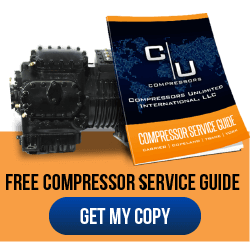

Not surprisingly, the compressor has been the focus of an enormous amount of ingenuity. Since the early days of Carrier air conditioners in 1915, compressors have advanced through many developmental stages.
With nearly a century of work behind them, it’s no surprise there are many types of cooling compressor suited for various applications. Three distinct types remain in wide use in the commercial marketplace:
- Piston
- Screw
- Scroll
In addition, there are three compressor system architectures to choose from. The decision of system architecture has a significant impact on how quickly and efficiently the system can be serviced. It also impacts the types of mechanical problems a compressor may be vulnerable to.
The three types of compressor systems are:
- Open
- Hermetic
- Semi-Hermetic
When comparing compressors from different manufacturers, you’ll inevitably be confronted by these options. The right selection for you will depend on your operating environment, load, and other factors.
Let’s take a closer look at modern compressors and how they differ:
1. Piston (Reciprocating) Compressors
The piston compressor, like the Carrier 06ET275360, is the simplest and most common compressor with the longest engineering history. In fact, it can be said that most other advancements have been an effort to improve on the piston compressor. But that does not mean you should overlook it!
Piston compressors are available in all types of configurations and all sizes. They are more affordable to source and install than most alternatives. A piston compressor requires constant lubrication and is sensitive to any intrusion of liquid at the inlet, which can lead to rapid destruction of the valves.
As the name suggests, this is a positive displacement compressor that uses pistons driven by a crankshaft to deliver high pressure gasses. Regular maintenance should focus on the pistons, crankshaft, and motor to prevent mechanical deterioration that affects performance over time.
2. Screw Compressors
A screw compressor, like the York DXS45, features either one or two helical screws rotating at high speed to compress the refrigerant gas. The twin-screw configuration consists of matched rotors that mesh closely in a common housing. The refrigerant enters and exits the compressor through ports, not valves.
Because the mating rotors have such close tolerances, cooling and lubrication are both essential to system life. Oil can be forced onto the compressor at specific points to ensure lubrication and seal the rotor-to-rotor and rotor-to-housing clearances. A failure of lubrication can cause substantial damage.
Screw compressors are known for excellent output and have a power range anywhere from 20kW to 1,200kW. They are bulkier than piston compressors and require more space. Proper lubrication can reduce the operating noise, but screw compressors tend to be loud and should be placed accordingly.
3. Scroll (Spiral) Compressors
Scroll compressors are generally the most sophisticated compressors and were first commercialized in the 1980s. Scroll compressors make use of radial movement in mating parts to reduce mechanical stress and optimize contact force even if small solid particles infiltrate the compressor.
Liquid slug can be automatically swept from mating components and vaporized, giving scroll compressors a much increased – but far from unlimited – tolerance for liquid. Gas pocket leakage is also reduced thanks to centrifugal forces along the sides of the scrolls while in operation.
A vastly reduced number of parts means the scroll compressor has fewer points of fault and is easier to maintain. With less torque variation, the engine is more reliable and the output generally higher. The standard power output is 40kW to 50kW, but multiple units can be combined in parallel.
4. Open Compressors
An open compressor, like the Carrier 5H80, unit is one in which the motor and compressor are separate. This enables the use of electric, diesel, or gas motors. All parts of the compressor are easily accessible for repair. In exchange for a larger footprint, an open compressor system is designed to offer higher power output.
5. Hermetic Compressors
In a hermetic system, the motor and compressor are encased in a hermetically welded envelope. The sealing system is not joint-dependent and it protects key components from the outside environment. That said, hermetic compressors cannot be open for repairs, and the risk of replacement offsets the low costs.
5. Semi-Hermetic Compressors
A semi-hermetic compressor balances the advantages of open and hermetic architecture by enclosing the compressor and the motor in a hermetic envelope, but the envelope can be opened to affect repairs. A liquid cooling system can be integrated directly into the casing for better thermal control.
Matching your compressor to your precise requirements enhances efficiency and prolongs service life. Remanufactured commercial compressors are available in all types and configurations, enabling you to replace aging compressors rapidly and at deeply reduced cost without compromising on performance.












